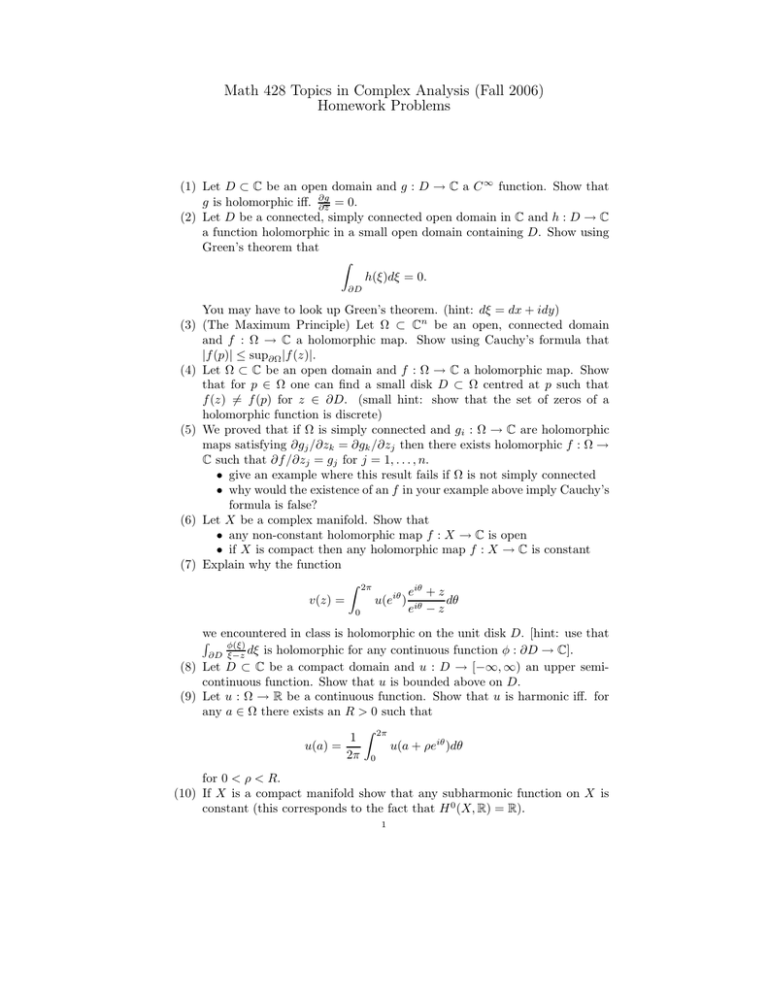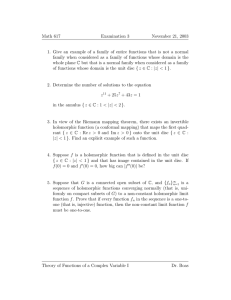Math 428 Topics in Complex Analysis (Fall 2006) Homework Problems
advertisement

Math 428 Topics in Complex Analysis (Fall 2006)
Homework Problems
(1) Let D ⊂ C be an open domain and g : D → C a C ∞ function. Show that
g is holomorphic iff. ∂g
∂z = 0.
(2) Let D be a connected, simply connected open domain in C and h : D → C
a function holomorphic in a small open domain containing D. Show using
Green’s theorem that
Z
h(ξ)dξ = 0.
∂D
You may have to look up Green’s theorem. (hint: dξ = dx + idy)
(3) (The Maximum Principle) Let Ω ⊂ Cn be an open, connected domain
and f : Ω → C a holomorphic map. Show using Cauchy’s formula that
|f (p)| ≤ sup∂Ω |f (z)|.
(4) Let Ω ⊂ C be an open domain and f : Ω → C a holomorphic map. Show
that for p ∈ Ω one can find a small disk D ⊂ Ω centred at p such that
f (z) 6= f (p) for z ∈ ∂D. (small hint: show that the set of zeros of a
holomorphic function is discrete)
(5) We proved that if Ω is simply connected and gi : Ω → C are holomorphic
maps satisfying ∂gj /∂zk = ∂gk /∂zj then there exists holomorphic f : Ω →
C such that ∂f /∂zj = gj for j = 1, . . . , n.
• give an example where this result fails if Ω is not simply connected
• why would the existence of an f in your example above imply Cauchy’s
formula is false?
(6) Let X be a complex manifold. Show that
• any non-constant holomorphic map f : X → C is open
• if X is compact then any holomorphic map f : X → C is constant
(7) Explain why the function
Z 2π
eiθ + z
dθ
v(z) =
u(eiθ ) iθ
e −z
0
we encountered in class is holomorphic on the unit disk D. [hint: use that
R φ(ξ)
dξ is holomorphic for any continuous function φ : ∂D → C].
∂D ξ−z
(8) Let D ⊂ C be a compact domain and u : D → [−∞, ∞) an upper semicontinuous function. Show that u is bounded above on D.
(9) Let u : Ω → R be a continuous function. Show that u is harmonic iff. for
any a ∈ Ω there exists an R > 0 such that
Z 2π
1
u(a) =
u(a + ρeiθ )dθ
2π 0
for 0 < ρ < R.
(10) If X is a compact manifold show that any subharmonic function on X is
constant (this corresponds to the fact that H 0 (X, R) = R).
1
(11) If X is a compact manifold show that all the eigenvalues of the Laplacian
∆ are real and non-positive. Hint: use that ∆ = dd∗ + d∗ d is a self-adjoint
operator and that
• if p is a local maximum of f then ∆(f )(p) ≤ 0 (concave down)
• if p is a local minimum of f then ∆(f )(p) ≥ 0 (concave up)
(12) Prove that Aut(H) ∼
= Aut(D) ∼
= P SL2 (R) where H = {z : Im(z) > 0} ⊂ C
is the upper half plane and D = {z : |z| < 1} ⊂ C is the open unit disk.
(try using one of Cartan’s theorems)
(13) Let B = {z : |z1 |2 + · · · + |zn |2 < 1} ⊂ Cn denote the open unit ball. Find
Aut(B). (this one looks interesting but perhaps tedious)
(14) Find a proper, surjective, continuous map f : C2 → C. hint: remember
that such a map cannot be holomorphic.
(15) Find an example of a bounded domain D and maps {fi } ∈ Aut(D) such
that f = lim fi is holomorphic but f 6∈ Aut(D).
(16) Find an (unbounded) domain D where Aut(D) does not act properly on
D. (not sure how difficult this is)
(17) Find Aut(Eτ ) where Eτ is the genus one Riemann surface Eτ = C/h1, τ i
for some τ ∈ H. Hint: There is a natural inclusion of groups Eτ ֒→
Aut(Eτ ). Show that the quotient is Z/2Z except when τ ∈ P SL2 (Z) · i or
τ ∈ P SL2 (Z) · eiπ/6 in which case it is slightly larger (these are the surfaces
with extra automorphisms). I encourage you to try this question.
(18) Show that Sp2g (Z)acts onthe Siegel upper half space Hg = {Zg×g : Z t =
A B
Z, Im(Z) > 0} by
: Z 7→ (AZ + B)(CZ + D)−1 . Does Sp2g (Z)
C D
also act by Z 7→ (CZ + D)−1 (AZ + B)?
(19) One can think of P1 (C) as the one point compactification
Ĉ of C.
a b
az+b
1 ∼
• (a) Show that Aut(P ) = P GL2 (C) where
acts by z 7→ cz+d
c d
• (b) Show that P GL2 (C) can map any three points p1 , p2 , p3 ∈ P1 to
0, 1, ∞.
• (c) Show that if A ∈ P GL2 (C) fixes 0, 1, ∞ then it must be the identity.
(20) Show that H 6∼
= C in two different ways.
(21) Show that Aut(Cn ) = GLn (C).
(22) Show that the locus in Cn satisfying f (z1 , . . . , zn ) = 0 cannot be a compact
manifold (here f is a holomorphic function). [hint: we mentioned a lemma
which pretty much showed this]
(23) The Riemann surface given by x3 + y 3 + z 3 = 0 in P2 has genus one.
Show indirectly that it must be the Riemann surface Eτ = C/h1, τ i where
τ = eπ/3 by considering it’s automorphism group (hint: Eτ is the only
genus 1 Riemann surface with an automorphism of order 3 which is not a
translation)
(24) Find an explicit degree three map f : P1 → P1 given as [x, y] 7→ [f, g]
(where f, g are degree 3 homogeneous polynomials) so that f has three
ramification points: one of index 3 and two of index 2.
(25) What is the genus of the Riemann surface obtained by identifying opposite
sides of an L-shaped table?
(26) Let f : C1 → C2 be a nontrivial map (i.e. doesn’t map C1 to a point)
between Riemann surfaces. Show that g(C1 ) ≥ g(C2 ) where g(C) denotes
the genus of C. Show that equality can hold only if g(C1 ) ≤ 1 or C1 ∼
= C2 .
(27) Show that the Mobius line bundle and the trivial line bundle on S 1 are not
isomorphic.
(28) Consider the vector subbundles V1 and V2 on the unit circle S 1 given by
the span of (cos(θ/2), sin(θ/2)) and (− sin(θ/2), cos(θ/2)).
• Show that V1 and V2 are isomorphic to the Mobius line bundle.
• Show that V1 ⊕ V2 is isomorphic to the trivial vector bundle I2 .
(29) Show that a real (or complex) line bundle L is trivial if and only if there
exists a non-vanishing section of L (i.e. a section which does not intersect
the zero section).
(30) In this exercise a line bundle means a topological complex vector bundle of
rank one.
(a) Show that a line bundle on S 1 must be trivial.
(b) Show that a line bundle on a bouquet must be trivial (a bouquet is
obtained from several copies of S 1 by glueing them together at a point).
(c) Show that a line on the complement of a small disk on a compact
surface is trivial.
(d) Conclude that (up to isomorphism) line bundles on a compact surface
are in bijection with Z via a clutching function (c.f. in class we did
this for S 2 ).
(31) If L1 and L2 are complex line bundles on a compact surface show that
deg(L1 ⊗ L2 ) = deg(L1 ) + deg(L2 ) (hint: if σi for i = 1, 2 are sections of Li
then σ1 · σ2 is a section of L1 ⊗ L2 ).
(32) Suppose 0 → E1 → E → E2 → 0 is an exact sequence of vector bundles.
Show that det(E) ∼
= det(E1 )⊗ det(E2 ). Conclude that deg(E) = deg(E1 )+
deg(E2 ).








